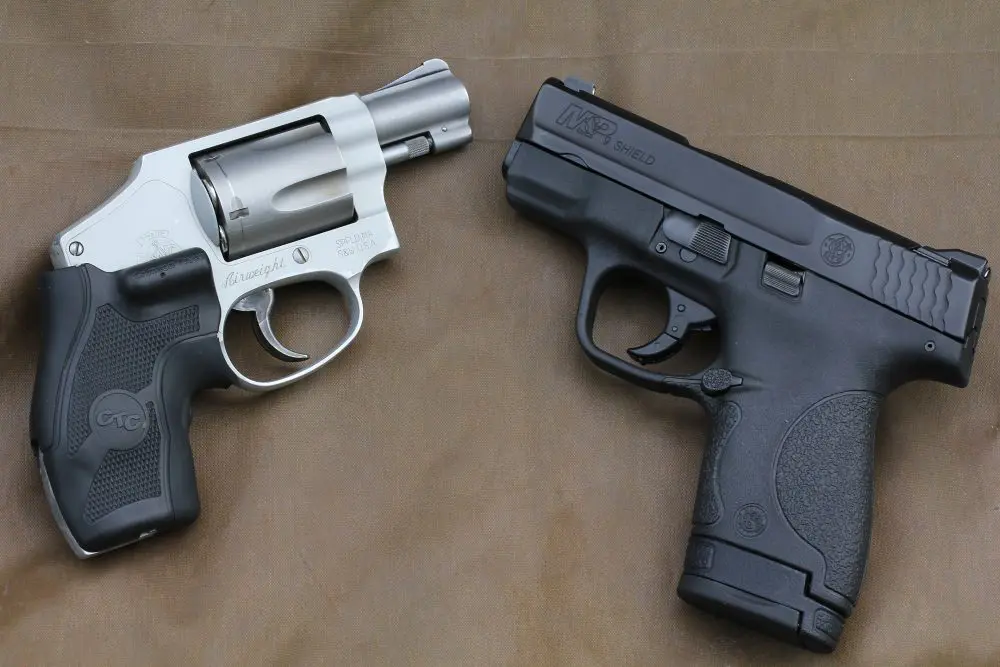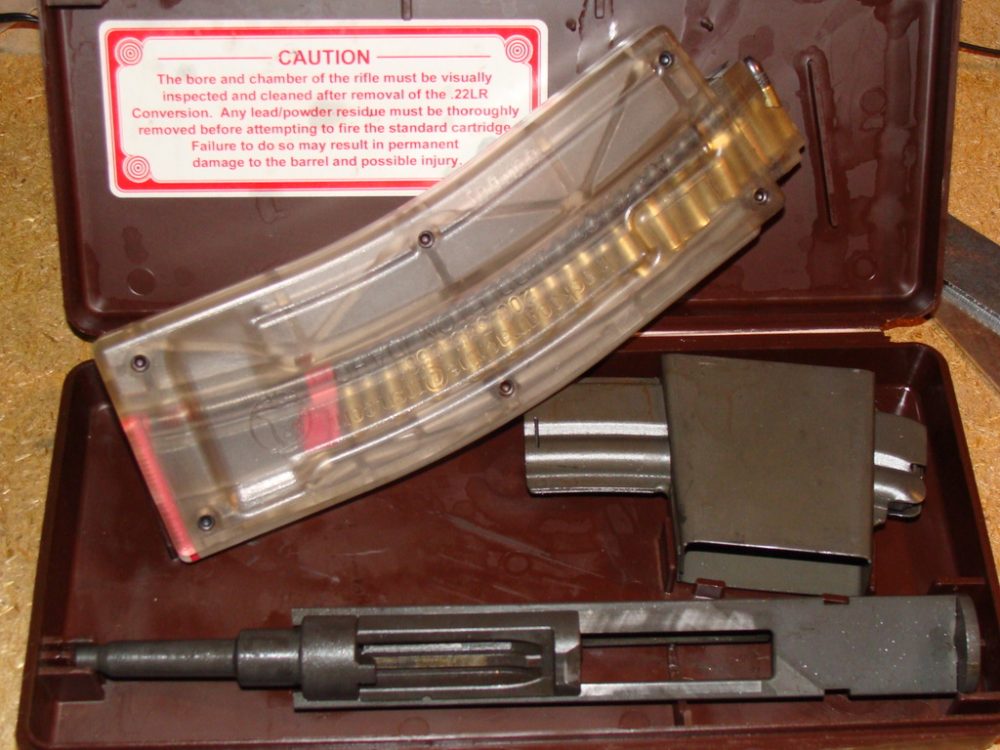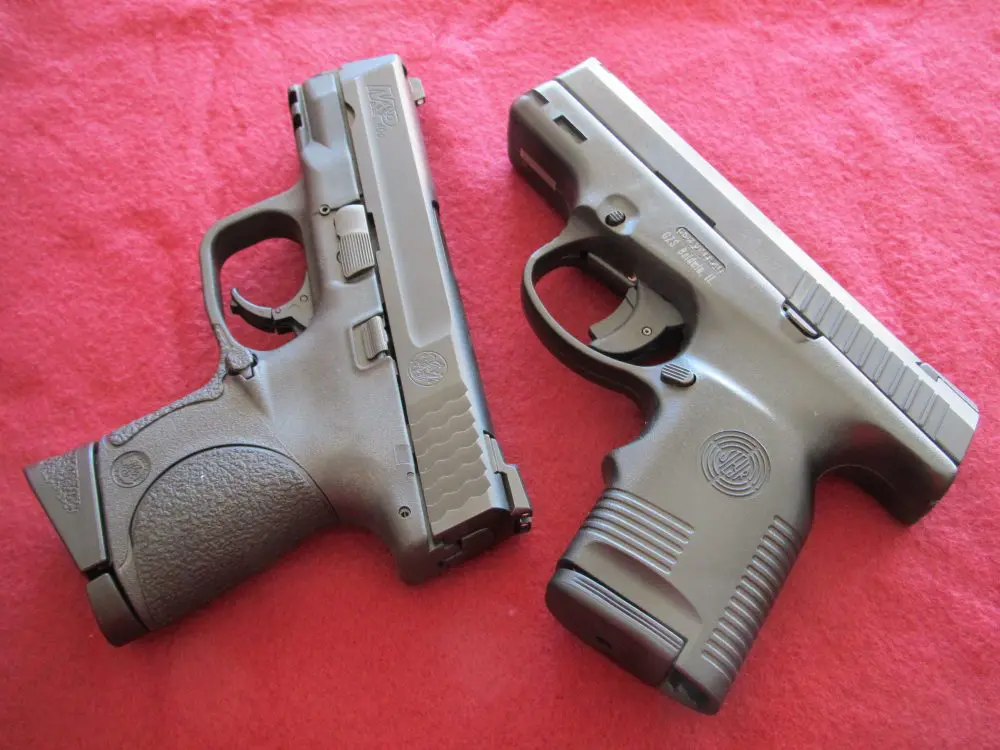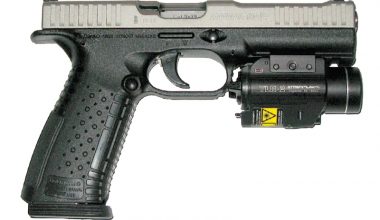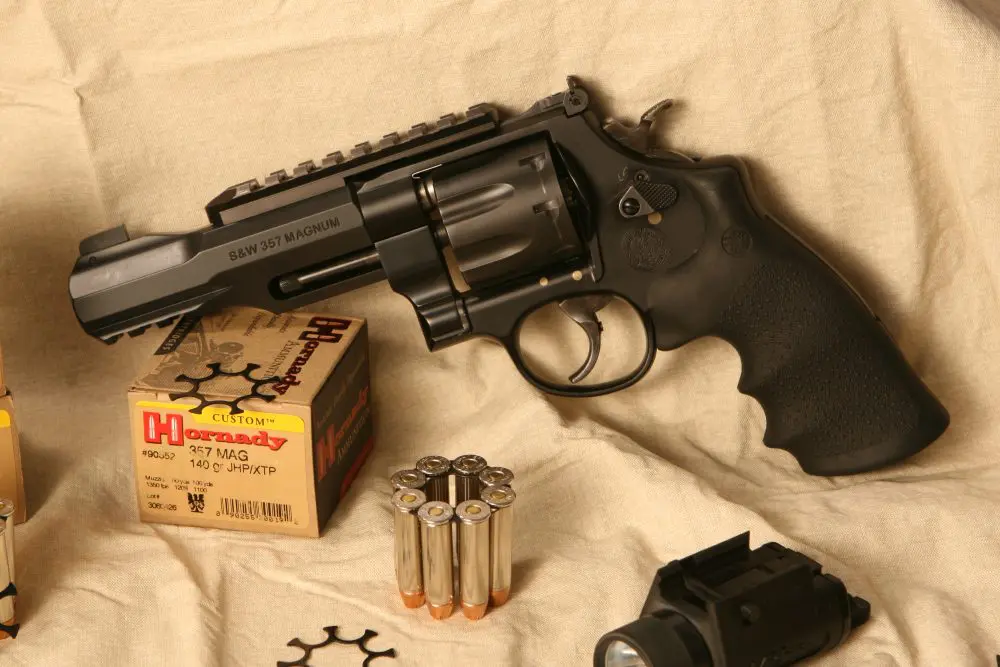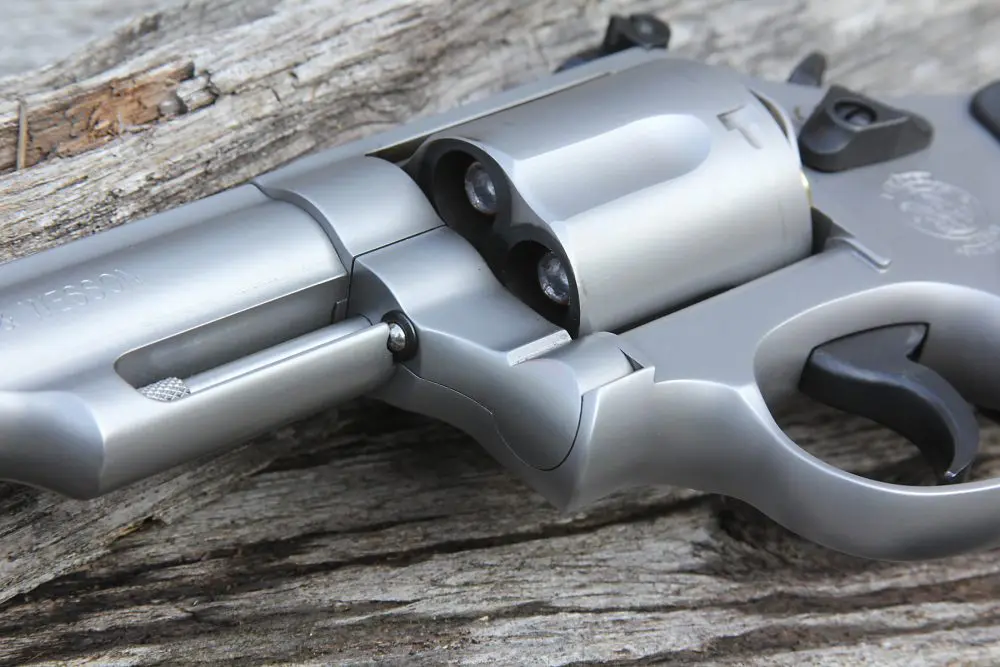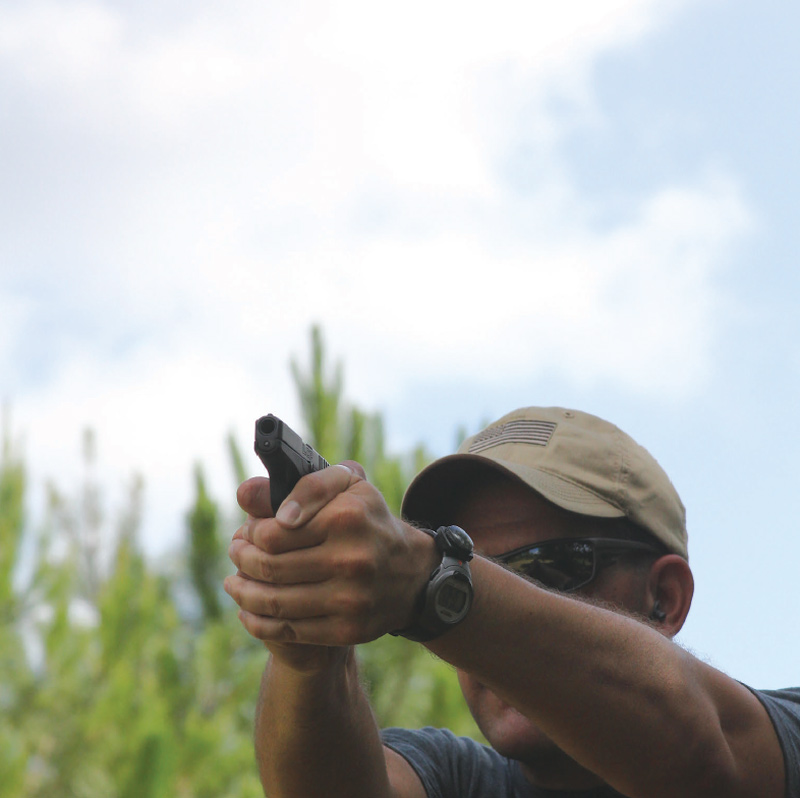
I recently stopped by the local pawn and gun and saw a Ruger LCP in the case. They have been hard to find for a while, so I asked to see it. I was immediately taken by the legitimate sight picture offered and smooth double-action-only trigger pull. I thought this might be very shootable despite its nine-ounce weight and tiny size, and I wondered how far I could “make it go.” After some haggling, I was on my way as an LCP owner.
While preparing for the shoot, I decided it would be a better event to wrap in an S&W J frame 642 airweight and a Glock 17 to represent the two most common pocket/back-up guns (BUGS) and the dominant American holster pistol.
The spate of recent violent incidents where a deranged shooter or terrorist has attacked public places has challenged what may have stood for conventional wisdom on what distances represent typical self-defense scenarios.
I thought an informal shoot to stretch the genre-leading pocket auto and snubbie out would be worthwhile. The Glock 17 would serve as a control in the experiment, both as a comparison to the common first responder service pistol as well as to what I as the shooter was capable of on the day of the tests.
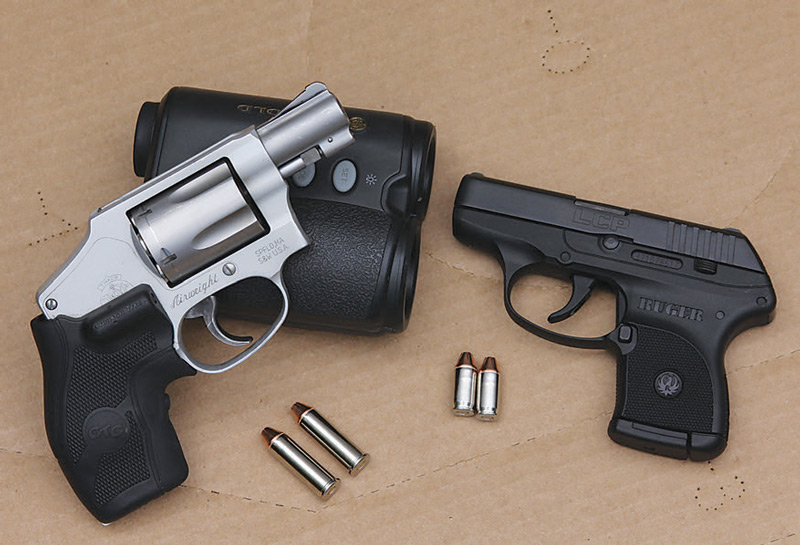
Table of Contents
THE LAYOUT
I decided to shoot the handguns at 10, 20, 40, 60, 80 and 100 yards. Each has a significance that we’ll get to in sequence. Each shortgun would get five individual shots at each distance with its caliber loading of Hornady Critical Defense ammunition.
The weapon would be presented to the target, standing two handed, precisely aimed and a shot pressed at close to a timed fire cadence of about five seconds per shot. Five individual shots—no mulligans, do-overs, excuses, or oopsies. This is representative rather than scientific, getting at what the pistol or wheelgun could do on demand in one shooter’s hands on a given day.
The science-minded are probably cringing and winding up to write Denny and demand I be issued a Ransom rest and specific instructions. But whatever this procedure lacks in scientific method, it more than compensates with honesty and practical application.
TINY GUNS AT TEN PACES
Ten yards is probably three steps farther than what many shooters envision the J or LCP are meant for. Ten is a long shot inside most residential or small business structures.
I chose a 3×5 card to challenge the handguns and represent a wellaimed shot to compensate for the ballistic iffy-ness of the BUGs. Easy day. The five Critical Defense 90-grainers were actually the first five shots ever fired in the LCP and went neatly into the center of the card. The J frame barked its cylinder payload into the card just as easily. Switching over to the Glock, the five shots overlapped into an impressive-looking group. No big surprises so far.
TWENTY YARDS
As you go out and about in town, you can see 20-yard intervals everywhere. After the theater shooting last year, I eyeballed my favored movie seating row at the next show I attended at about 20 yards from the commanding position up front. For this yard line, I chose an eight-inch steel plate as a target, representing a solid center hit.
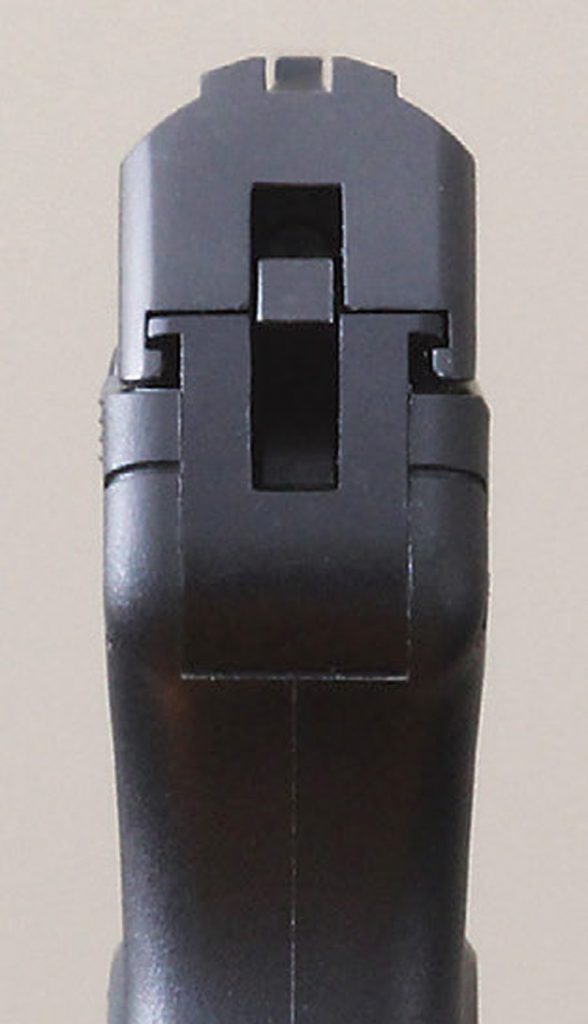
Presenting the little guns to the plate at that distance, there was very little “meat” to spare around the sight picture. I had to apply some effort to bear down on the front sight and smoothly press the trigger through the arc on both little guys. The J went five for five. I got a bit overconfident on the tiny Ruger after a couple of hits and lost discipline—one shot slipped right by the plate. I desperately wanted a do-over, but held to the ground rules and scored four hits. The Glock made getting five hits substantially simpler for the shooter.
FIELD-GOAL RANGE
Backing off to 40 yards, I switched to a 16×22-inch steel chest plate to represent torso hits. The distance was chosen to correlate with the distance between major aisle intersections in my local big box store, where a crazy might choose to stake out key terrain.
In any given superstore in my region, it’s probable there is at least one good guy with a snubbie or .380 on board. However, this distance was where I was beginning to get genuinely curious about on-demand hit potential. It didn’t seem like too hard of a target, and the Smith & Wesson put five of the Hornady .38 Specials into a nine-inch group that had four in the A zone.
I again slipped one out with the LCP, with the four impacts dispersed evenly. The pistol’s endearing weight and thinness are a double-edged sword when the shooter goes to stroke through 6.25 pounds of trigger resistance without disturbing the sights.
The control pistol rang steel five times with no fuss.
PUSHING IT
Since most carbine classes stop at 50 yards, it might seem optimistic to shoot at a chest plate ten yards beyond, but with success up to this point, I was feeling pretty good about my chances.
Going back to the wacko in the big box or mall scenario, the distance matches up to the long aisles or court areas, respectively. Sixty yards didn’t look that far away until I put the pocket guns out at arm’s length, and then it looked like a very long way out. It was definitely work to keep the sights locked on the now not-so-generous chest plate while rolling the trigger.
Frequently in military training, 80% is the qualification standard. There’s a saying that “80 pays the rent.” Both the Smith and Ruger paid out at four hits on the chest plate. Each group was strung vertically with relatively small lateral dispersion, showing that I was having trouble holding elevation on the snagfree fixed sights in the bright overhead sunlight.
The Glock again showed it was digging the 115-grain Critical Defense FTXs with an eight-inch five-shot group that clustered the best three into 1.75 inches.
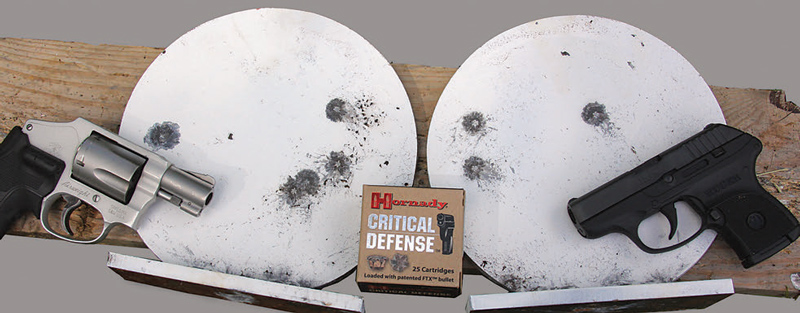
OUTER LIMITS
Stepping back another 20 yards to 80 as measured by a Leupold laser rangefinder, the target was officially a long ways off. There are probably some sporting event, open air and parking lot scenarios that could apply, but the BUG was looking pretty meager as the means to affect the target.
The 642 was up first. I could not make it happen with the five rounds in the cylinder. The Airweight’s stainless sight picture is adequate, but not necessarily ideal, and at 80 yards I could not keep the level of sight picture required and compensate for the .38 Special bullets beginning to drop.
Double-action triggers usually do not bother me at all, but this target/ distance made me wish the J had a little lighter press. I was supremely frustrated to get no hits, but that was the best I could do for those five shots at that moment in time. Perhaps if a cloud had passed overhead and given me the perfect light or with a better breakfast, good night’s sleep, or…. The gun could probably do it, and I probably could, but I didn’t right then.
The better sights on the LCP and lighter trigger were immediately obvious on this shooting problem, and the Ruger flung two of the five .380s onto the steel. I have to say I was pretty impressed. I wouldn’t dream of being able to hit at 80 with most of the other “mouseguns” in the LCP size envelope. As mentioned, the LCP has a surprisingly good DA pull—a recent inline product improvement by Ruger. I had put a couple of drops of FireClean lube onto the hammer to run into the sear before the test, and it made the pull even smoother.
Shooting the control group with the Glock, I again lost discipline and one shot broke a little high and I called it just barely over the plate. If there had been a head on the steel, I would bet a steak that it would have caught, but the 9mm got four out of five on this round in a well-centered 11-inch group.
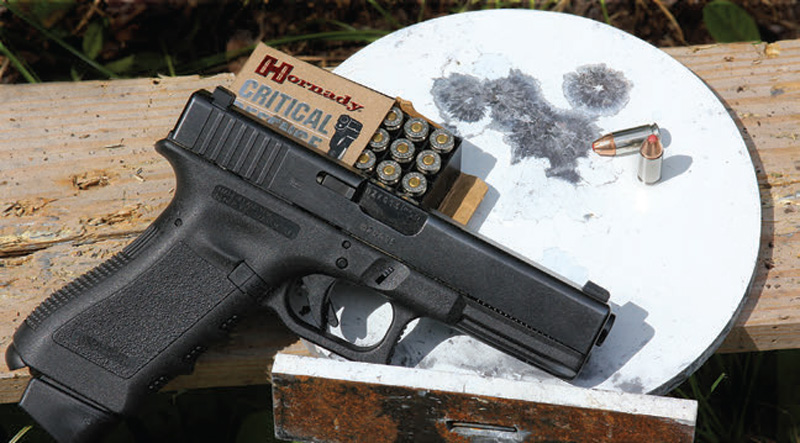
100 YARDS?
One hundred yards is probably more closely associated with group testing scope-sighted rifles than shooting pocket guns, but I wanted to see what was possible. For this stage, I enlisted the aid of a pickup truck and shot braced over the bed cover as in a parking lot or open-air situation.
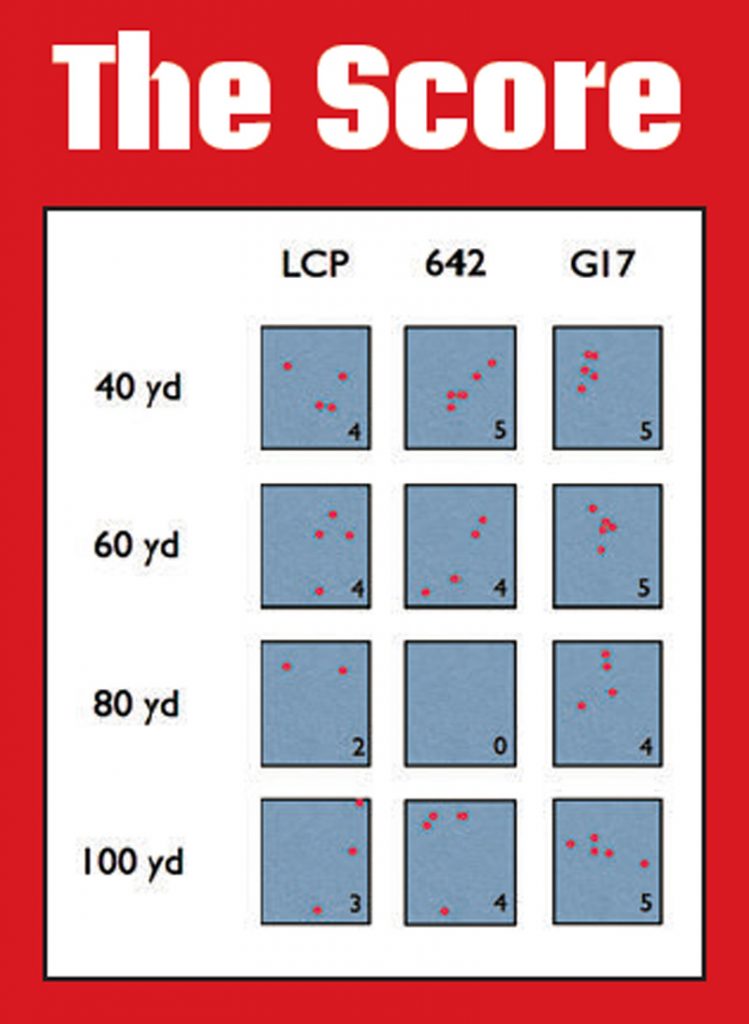
I had already proven that 80 was past the maximum effective range for me on the hideouts, so thought I could extend the range some with improvised support as would be available most places, whether braced over a table, trash bin, or vehicle.
The extra challenge at this distance was the bullet drop, which with both calibers out of the short barrels was an issue. You have three basic options at distance: hold at the neck and hope the bullet drops onto the lower torso, hold high and hope the sights are aligned over the target which is now under the sights, or elevate the front sight.
For the five shots with both little guys, I tried to get a feel for the drop and how to hold to compensate for it. I ended up with one hit with the .38 and none with the .380. This result is probably representative of most on-demand attempts at such an extended range.
But I couldn’t just pack up and leave. I figured it would be informative to see what the weapons could do once the hold was right. I loaded another cylinder and magazine and gave it another go. With a better idea of the drop and hold, the 642 plunked steel four times out of five with the shot interval stretched to a more deliberate 10 to 15 seconds per shot. So much for snubbies only being good at arm’s length!
Swapping over, it took the first two shots to finally get the range with the LCP. The following three FTX bullets dropped onto the plate in a group that used all the available real estate. Still, hits are hits at that distance, and I left with a newfound appreciation for the capabilities of such a small piece.
I had shot the Glock at distance on a number of occasions, and the 9mm Luger doesn’t drop excessively out of a service-length barrel. The first five braced shots all rang steel at near the timed fire cadence. The group dispersed laterally about 14 inches, with the best three in a noteworthy 4.5-inch cluster at the edge of the A zone. There is no doubt which pistol I would rather have in my hands!
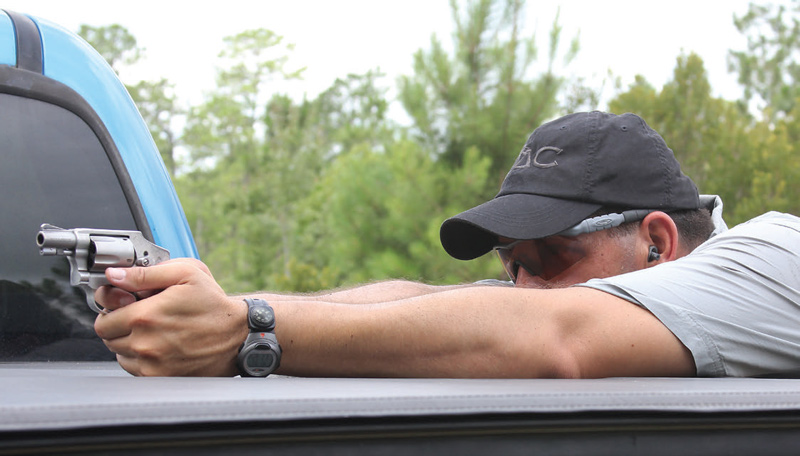
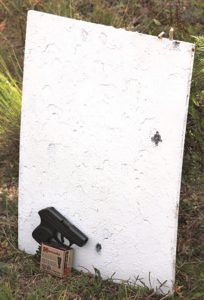
NOW WHAT?
I gained a new respect for the two most common concealed-carry handguns. With good ammo and some effort by the shooter, they can influence a problem at impressive distances. I encourage you to try for yourself and see what your max effective range is. Just because you can doesn’t necessarily mean that you should, however.
Whether it makes sense or is responsible to start flinging .38s at some goon out at an extended range is a whole ‘nother issue that you will have to sort out on the ground. And it’s worth noting that just because you can hit to the next ridgeline with a pocket gun doesn’t change the ballistic properties of the bullet—there may or may not be enough oomph to solve the problem.
This test looked at accuracy disconnected from the more frequent engagement scenarios. In a future issue of S.W.A.T., we will look at how concealedcarry guns stack up close and fast.
